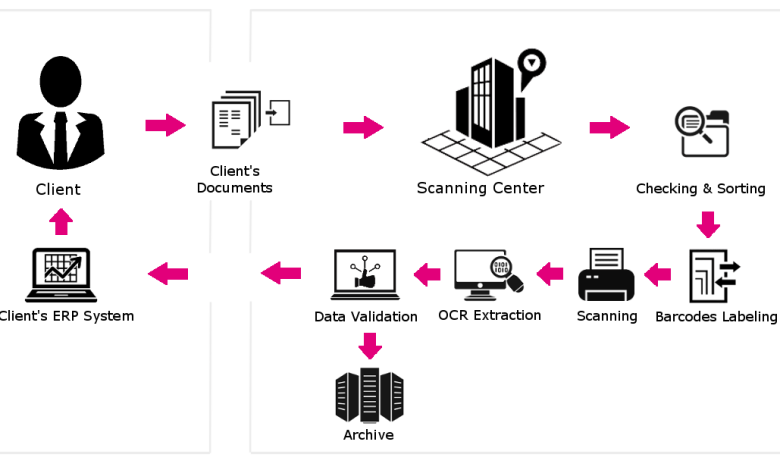
What is document digitization?
Over the last decade, organizations have seen the volume of information they had to deal with growing at an exponential rate.
Far from achieving the desired paperless office, much of this data arrives in the form of documents that make it difficult to share and use to optimize decision-making.
This is where digitization, document scanning, comes into play, a process that is no longer as complex or as expensive as before, and can even outsource the service.
In this way, all this flow of unstructured data is transformed into a structured format, which can be read and processed by computers. The digitization of documents and document management, therefore, go hand in hand.
What is the digitization of a company’s documents?
When we talk about Intelligent document processing, the leap from the analog to the digital world extends to all types of companies and sectors.
However, it would be a mistake to reduce document digitization to mere scanning, to that conversion into bits of information since it requires a series of previous and subsequent tasks that cannot be ignored. Digitization (Like digital onboarding) implies the treatment of that information so that it is treatable.
In this way, before carrying out the digitization itself with the help of scanners, all the documents must be collected wherever they are –sometimes outside the facilities themselves- and prepared them for digitization.
This sometimes involves certain manual tasks, such as removing clips or staples from sheets of paper and classifying them by document type to avoid confusion once scanned.
After scanning, the digitization is not complete without subsequent optical recognition, so that the semi-structured content is identified and the audiovisual content is properly treated, considering elements such as special characters or barcodes.
Once this process is done, it would be recorded and verified in the system, validating each record so that it conforms to the indexing rules established in the format you want to export (txt, MDB, XML, pdf…).
What benefits can digitization bring to your company?
- Storage and maintenance savings. The storage space required for digitized documents is significantly less than that required when they are on paper. In 1 TB, which is the minimum capacity of many hard drives, you can fit 6.5 million pages of documents, that is, the equivalent of 1,300 shelves full of paper documents. It is not just about reducing space, but also the cost associated with it, since archives and warehouses often come with rentals, air conditioning, security…
- Accessibility to information. When the information is correctly digitized, classified, and indexed, its access is immediate. Document digitization provides faster data recovery, reducing information search times and, in addition, being able to do so and share it from any place and device.
- Easier data processing. Having all the information stored, accessible, and digitally classified in a common repository allows you to immerse yourself in big data, that is, cross-data that was previously dispersed and forgotten in airtight silos to extract relevant information quickly and easily.
- Documentation security. Once the documents have been digitized, it is possible to establish security policies that not only shield the information from malicious attacks but also define different profiles and access privileges based on their role. In this same sense, the software allows guarantees the integrity of the documents, offering traceability of any modification made. Likewise, the digitization of documents opens the door to backup copies to maintain insurance in case of computer, natural, etc. disasters. with a view to business continuity.
- Environmental Protection. People usually think of the tons of paper saved by document digitization; however, this protection for the environment goes much further, since taking the digital leap also drastically reduces the carbon footprint associated with the manufacture and use of photocopiers and scanners, not to mention the enormous number of consumables (ink cartridges and toner) they require.
Documents that can be digitized
In a company, the variety of documents that can be digitized to gain agility and operational efficiency is transversal, including practically all departments:
- Information related to customers and suppliers:
- Contracts: These are the legal documents that determine the relationship between the two parties and that sometimes must be consulted on a regular basis. Its digitization simplifies these accesses as well as its monitoring in the case of recurring renewals.
- Invoices: The volume of invoices is enormous, adding those of clients and suppliers. Its management within the information flow of any organization is streamlined thanks to the incorporation of electronic invoicing and certified digitization that even allows the elimination of the original on paper.
- Delivery notes and orders: In both cases, being able to access the information anywhere and from any device can solve many problems in situations such as the distribution of merchandise.
- Policies: In the case of insurance companies, these are frequently consulted documents in case of any claim or renewal; the speed that is required, especially in the first case, requires practically real-time access, something that only digitization offers.
- Audiovisual material: Closely related to the previous point and, specifically, to sectors such as insurers, the digitization of audiovisual documents of claims is essential in the event of future claims or other incidents by customers.
- Information related to Human Resources and Finance:
- Contracts and payroll: Especially in medium-sized and large companies, having this digitized documentation in a single repository simplifies the work of the HR area, which usually generates files that include all the information of each employee.
- Financial statements and tax documents: All financial documentation, generally subject to strict legal requirements, lends itself to digitization, firstly because the Administration requires it and, secondly, because it increases the support and security of information so critical for business continuity.
Docbyte’s digitization service. What is the digitization process like?
Document digitization has become a key element to gaining agility and not being left behind in decision-making compared to the competition.
However, it is a task that can consume many resources without providing added value to the business. For this reason, relying on the outsourcing of this function with an expert provider such as Docbyte is the best option.
Docbyte’s cutting-edge technology and its intelligent capture of information allow for increased operational efficiency while guaranteeing security and regulatory compliance.
The company has state-of-the-art OCR engines, Artificial Intelligence technology for the interpretation of structured and unstructured documents, and a multi-platform environment that allows it to operate in all types of systems and applications, regardless of the format and information input channel.




